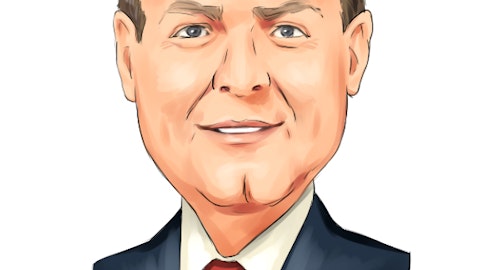Blue Tower Asset Management LLC, an investment management firm, published its second-quarter 2021 investor letter – a copy of which can be downloaded here. A quarterly net return of 13.03% was recorded by the fund in the second quarter of 2021, adding to its significant gain in Q1. You can take a look at the fund’s top 5 holdings to have an idea of their top bets for 2021.
In the Q2 2021 investor letter of Blue Tower Asset Management, the fund mentioned Cornerstone Building Brands, Inc. (NYSE: CNR) and discussed its stance on the firm. Cornerstone Building Brands, Inc. is a Cary, North Carolina-based commercial construction industry with a $2.08 billion market capitalization. CNR delivered a 78.23% return since the beginning of the year, extending its 12-month returns to 101.71%. The stock closed at $16.18 per share on August 24, 2021.
Here is what Blue Tower Asset Management has to say about Cornerstone Building Brands, Inc. in its Q2 2021 investor letter:
“While Cornerstone has been engaged in several M&A transactions since the formation of the company from NCI Building Systems and Ply Gem, this quarter saw their first major divestment of a subsidiary. On June 7th, Cornerstone announced that it had reached an agreement with the Nucor Insulated Panel Group to sell Cornerstone’s Integrated Metal Panels business for $1 billion. The Insulated Metal Panels (IMP) business was a legacy subsidiary of NCI and was focused on serving the needs of industrial and commercial clients. The IMP business generated revenues of $349M in 2020. The EBITDA margin for the commercial segment that contained IMP was 14.2% in 2020. If we assume that the IMP business had the same EBITDA margin as its segment, this gives a 2020 EBITDA contribution of $50M. By comparison, the pro forma Adjusted EBITDA for Cornerstone on the whole is $609M.
This sale appears to be accretive for the value of Cornerstone as their net debt after the transaction1 is $2.22 billion, down from $2.97 billion at the end of Q1 2021. Therefore, Cornerstone gave up 8% of their total consolidated EBITDA in exchange for a cash payment equal to 15% of their enterprise value.
This will decrease their new debt-to-EBITDA level to approximately 3.9×2 and moves up their date for reaching their target debt-to-EBITDA level of 2.0-2.5x by a full year.The central idea of our investment philosophy is to buy businesses at bargain valuations. As most stocks trade roughly near their intrinsic values, we must always ask ourselves why businesses appear to have been misjudged by equity markets. In the case of Cornerstone, we believe this was due to three main factors. 1) The large transactions and mergers associated with combining NCI and Ply-Gem created many one-time expenses and hid the underlying profitability of the business. 2) The large amount of debt held by the company caused many institutional investors to be unable to invest in the company due to mandate restrictions. 3) We held the belief that the construction sector, a cyclical industry, was likely to outperform the overall US economy as the country had been building an insufficient amount of new housing for at least the past decade. As the company realizes acquisition synergies, the housing boom continues, and Cornerstone pays down debt, the company’s value will become apparent to investors and share price will rise to meet its true fundamental value. Investors who were previously repelled by the high debt levels will invest at lower leverage levels. The share price has already tripled from the average price our long-term investors in the strategy composite paid, but we still believe the company has a high expected forward rate of return.”

Photo by Scott Blake on Unsplash
Based on our calculations, Cornerstone Building Brands, Inc. (NYSE: CNR) was not able to clinch a spot in our list of the 30 Most Popular Stocks Among Hedge Funds. CNR was in 20 hedge fund portfolios at the end of the first half of 2021, compared to 27 funds in the previous quarter. Cornerstone Building Brands, Inc. (NYSE: CNR) delivered a -0.48% return in the past 3 months.
Hedge funds’ reputation as shrewd investors has been tarnished in the last decade as their hedged returns couldn’t keep up with the unhedged returns of the market indices. Our research has shown that hedge funds’ small-cap stock picks managed to beat the market by double digits annually between 1999 and 2016, but the margin of outperformance has been declining in recent years. Nevertheless, we were still able to identify in advance a select group of hedge fund holdings that outperformed the S&P 500 ETFs by 115 percentage points since March 2017 (see the details here). We were also able to identify in advance a select group of hedge fund holdings that underperformed the market by 10 percentage points annually between 2006 and 2017. Interestingly the margin of underperformance of these stocks has been increasing in recent years. Investors who are long the market and short these stocks would have returned more than 27% annually between 2015 and 2017. We have been tracking and sharing the list of these stocks since February 2017 in our quarterly newsletter.
At Insider Monkey, we scour multiple sources to uncover the next great investment idea. For example, Federal Reserve has been creating trillions of dollars electronically to keep the interest rates near zero. We believe this will lead to inflation and boost real estate prices. So, we recommended this real estate stock to our monthly premium newsletter subscribers. We go through lists like the 10 best EV stocks to pick the next Tesla that will deliver a 10x return. Even though we recommend positions in only a tiny fraction of the companies we analyze, we check out as many stocks as we can. We read hedge fund investor letters and listen to stock pitches at hedge fund conferences. You can subscribe to our free daily newsletter on our homepage.
Disclosure: None. This article is originally published at Insider Monkey.





